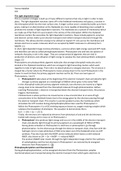Essay
BTEC Applied Science: UNIT 10C DISTINCTION
- Course
- Institution
Unit 10: biological molecules and metabolic pathways Learning aim c: explore the factors that can affect the pathways and the rate of photosynthesis in plants. BTEC Level 3 Extended Diploma in Applied Science At Distinction grade level. With hand drawn graphs and with my OWN research (plagiarism...
[Show more]



